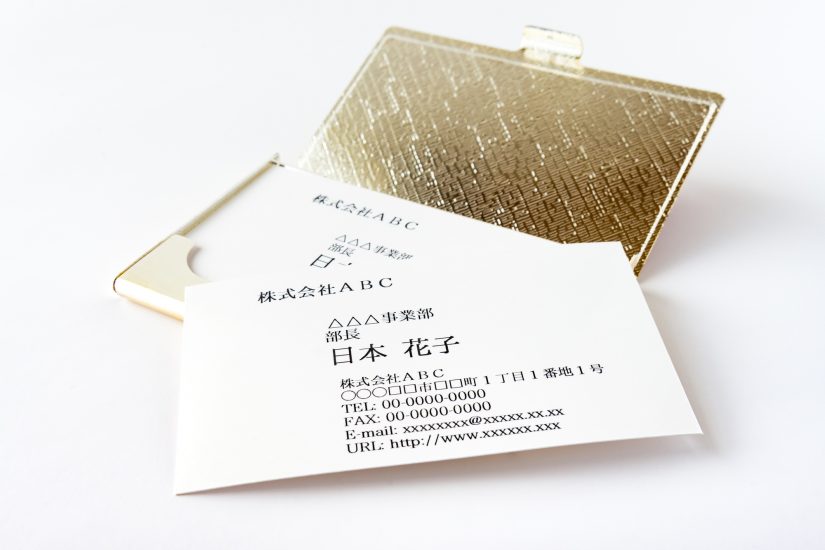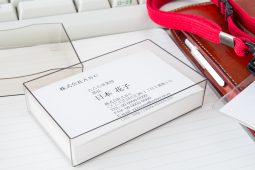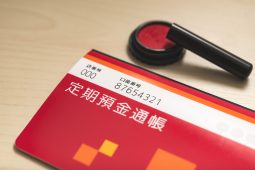Business cards, or 名刺 meishi in Japanese, are everywhere in Japan. Kids practice making them in school, people who don’t have jobs make cards to hand out their contact details to new acquaintances, and they mark an essential part of every business encounter. You will have business cards in Japan, whether supplied by your employer or you design your own. It’s inevitable.
Such vital parts of adult life in Japan will, of course, have a web of etiquette and cultural values around them. In this article, I’ll look into the role of business cards and some basic rules regarding their use.
Your Business Card
Of course, business card design follows a similar pattern no matter the country. It will include the person’s company, job title/role, name and some contact information. All of that is pretty standard.
In addition, as a non-Japanese resident your business card will very likely be bilingual English and Japanese. Even if your native language is not English, this is standard practice in Japan. If you would like something different, of course, you can talk that over with your employer or design your own, but many Japanese workers also follow this pattern.
Sometimes you will have the Japanese on one face and English on the back, or English below Japanese on the same face. What this means is, as a rule, if someone hands you their business card and you see only Japanese, try looking on the back to see if the English is there to help you read the person’s name, etc. If it isn’t, you might want to confirm the name’s pronunciation to help you remember.
The Basics
Keep your cards in a case. You can get very cheap metal or plastic ones at so-called 100-yen shops, but if you are going to be meeting anyone of importance they will be looking at the details of your dress and accessories, so it might be worth it to invest in a more expensive leather case.
Take your cards everywhere. It never hurts to have a way to hand out your contact details, even in private life. If you want someone you meet to be able to contact you, take out a card and write your cellphone number on it (it’s OK to write on your own card. NEVER write on someone else’s card where they can see it. More on etiquette in a moment.).
Update your cards regularly with new job titles, certifications, contact etc. It’s pretty bad form to white-out and write over old cards, so just get new ones. They tend to be very reasonably priced.
The Rules
Here is where it gets tricky. Just so you know, as a non-Japanese employee the rules will be slightly looser for you, but still it’s never a bad idea to respect local manners and etiquette.
Basic Rules
When going to meetings or visiting clients, keep your card case somewhere easy to find. This means in your jacket pocket or bag (try to avoid pants pockets). If a new face shows up, you should be ready to bring out your case at a moment’s notice. It’s bad form to fumble and search for your cards.
When passing you card to someone, hold it in both hands at the near corners with the logo and name facing your partner. They will do the same. Try to keep your card lower than theirs. When the cards are both out, take your partner’s card with your right hand, and they will take yours at the same time. (Yes, this is often a time of confusion. Watch your colleagues to see how they handle it.)
When you receive a card, look at it and read it, then place it on the table to your left on top of your card case when you sit down. Don’t put it in your case right away. Don’t bend it. Don’t write on it. Consider it a very important document until you get home and scan it into your contacts. As long as you are in that person’s presence, treat that card with respect. It’s good manners, and will earn you some points in their eyes for sure. Speaking of scanning, it’s definitely what people do now, but it’s not a bad idea to keep the cards around in an index box just in case you lose your data or need to confirm something on the back.
Advanced Rules
These are things that even Japanese employees often struggle with, so worry less about these. If you can master these rules, though, you’re sure to impress!
The consultant/seller/requester of the meeting puts out their card first. This reflects their lower status: if you are trying to sell your services, you want to boost your partner’s ego a little.
When exchanging multiple cards (like at a meeting with many new faces), exchange in descending order of importance. So, give your card to the most important person first, then go down the line. This gets very confusing when there are multiple people on each side, but a good rule of thumb is to go by seating order because seating order often reflects relative rank.
Again, when exchanging multiple cards, arrange the cards you receive on the table in descending order of importance. The highest-ranking card goes on top of your card case, then the rest should be lined up below that in order.
Mastering these rules isn’t exactly simple, and often non-Japanese are let off easy, but it can really make you stand out in the eyes of business contacts. Give it a try!








